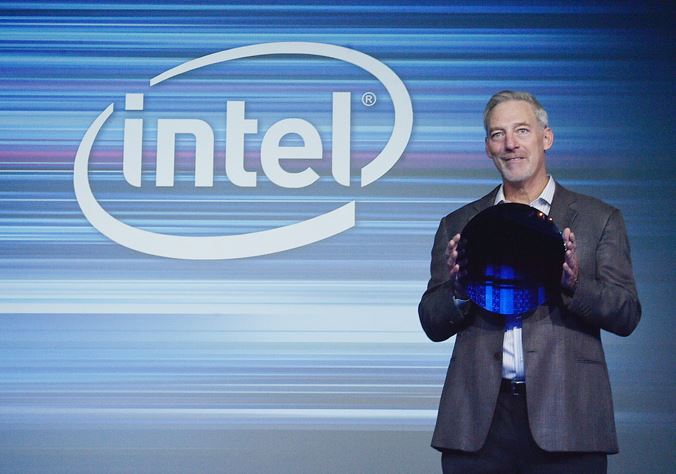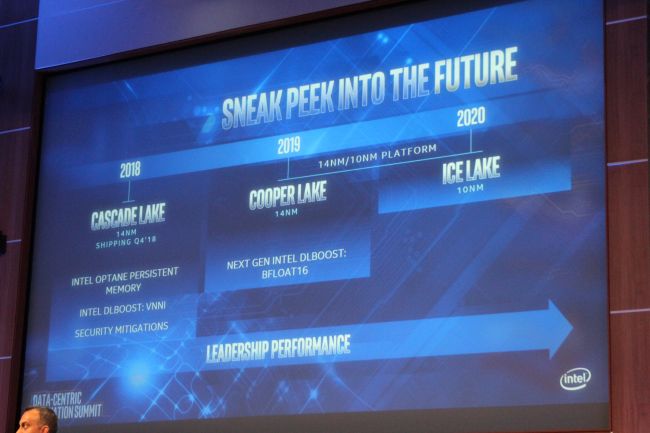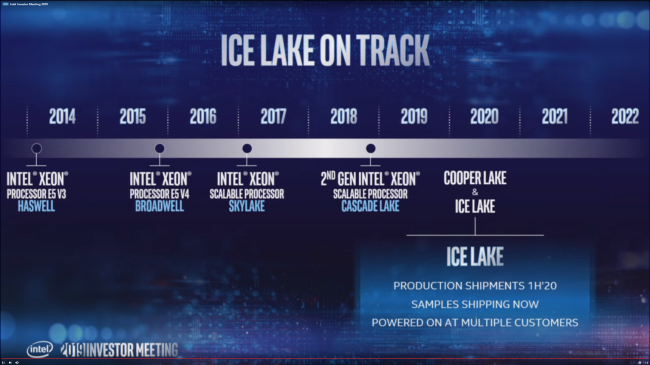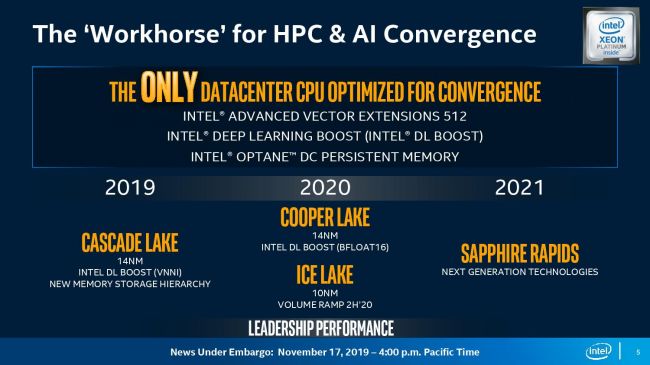Intel Refutes Reports of Further Roadmap Delays
What, me worry?

A report from SemiAccurate today claimed that Intel has significantly delayed its "entire server roadmap," and a follow-on report from Wells Fargo analyst Aaron Rakers, which cites the SemiAccurate report and "industry checks," seemingly reaffirms that Intel has hit yet another roadblock on its path to recovering from its incessant 10nm delays, thus impacting delivery of the Ice Lake processors for the data center.
However, in a statement sent to Tom's Hardware, Intel maintains that its data center roadmap remains intact and on-schedule:
"Intel remains on track for delivery of the Whitley platform starting with production of Cooper Lake in H1 2020 followed by Ice Lake production in H2 2020. We are also on track to follow Whitley with the delivery of Sapphire Rapids in 2021," an Intel spokesperson said.
These remarks echo the company's reassurances this week to its investors at the UBS Global TMT Conference. In response to a question about Intel's ability to compete given that AMD now has the process lead, Dr. Murty Renduchintala, Intel’s group president of the Technology, Systems Architecture & Client Group and chief engineering officer, responded:
"[...]And of course by the end of 2020, we'll come out with Ice Lake, our first 10nm server solution that brings important performance-per-core benefits to the surface. So all in all, I think we have an aggressive roadmap that we feel pretty good about to deal with the competitive landscape."
When asked if he was "just reconfirming that Ice Lake will be out in the second half of 2020," Murty replied saying "yes."
We've spilled a lot of ink on Intel's delayed 10nm node and the impact it has had on the company's competitive positioning. Intel’s delays have left the door open for AMD to capitalize with its capable Epyc Rome processors and intensified industry interest in alternative architectures, like ARM.
Get Tom's Hardware's best news and in-depth reviews, straight to your inbox.
Intel's repeated delays have left many to question the company's ability to execute on the troubled 10nm process. But according to Intel's repeated statements, the Whitley platform, which will support both 14nm Cooper Lake and 10nm Ice Lake processors, is on track.
Intel CEO Bob Swan also remarked on the roadmap in the company's third-quarter earnings call in October:
"And in terms of competitive dynamics, I would just say that, we've got a great lineup of products. We got Skylake to Cascade Lake first half of next year we're looking at Cooper Lake. As we talked before, we're really excited about Ice Lake server coming out in the second half of next year[...]," he said, as per a transcription via Seeking Alpha.
Determining if Intel is on track can be tricky, and the company's data center roadmap has seen its share of delays in the past. The company told us in August 2018 that Cooper Lake would arrive in 2019 but presented a new roadmap in May 2019 at its investor meeting to reflect the new arrival date of 2020.
That means Intel's statement today references the above roadmap, issued in May 2019, as the current timeframe for delivery. It's noteworthy that this roadmap says production shipments of Ice Lake begin in the first half of 2020, while the company's recent statements say production begins in the second half of that year.
Finally, Intel presented this roadmap at its HPC Developer Conference in Denver, Colorado, last month. This roadmap reiterated the arrival of Cooper Lake and Ice Lake in 2020 and added Sapphire Rapids, which will power the exascale Aurora supercomputer, in 2021.
Intel's last two roadmaps, Murty's comments last week, Swan's comments in October and Intel's statement today all point to Cooper Lake, Ice Lake, and Sapphire Rapids adhering to that schedule.
But the proof is in the pudding. Both SemiAccurate and Wells Fargo's Rakers claimed that Intel's roadmap has slipped further. Although Intel refuted those claims directly today, its incessant delays on 10nm products mean we won't know the absolute truth until the company begins shipping the silicon. Given the error of margin with Intel's roadmap projections, it's possible we won’t know if Ice Lake is actually on track until December 31, 2020.

Paul Alcorn is the Editor-in-Chief for Tom's Hardware US. He also writes news and reviews on CPUs, storage, and enterprise hardware.
-
JayNor Intel released 10nm Ice Lake laptop chips first. Those are in 30 laptop designs.Reply
Their 10nm 3D hybrid Lakefield chips are announced in two designs.
Their 10nm NNP-I chips are shipping.
Their 10nm Agilex FPGA chips are shipping.
on the AMD competition ... no 7nm apu, no 3D manufacturing design, no NNP chips, no FPGAs. -
everettfsargent "Given the error of margin with Intel's roadmap projections, it's possible we won’t know if Ice Lake is actually on track until December 31, 2020. "Reply
Actually, any announcement after Black Friday 2020 (2020-11-27) shouldn't count towards a 2020 release. Particularly, if there are continuous supply constraint issues, SKU's are not available for DIY builds or they are vastly overpriced SKU's (which is what happened when Skylake was released (announced in August 2015) later in 2015 with prices $100+ above MSRP).
So anything announced after say September 2020 counts towards calendar Q1 2021, if there are any significant supply or pricing issues during the 2020 holiday buying season.
Do you want 10th generation 14nm desktop silicon in the March 2020 time frame or do you want 11th generation 10nm desktop silicon in the September 2020 time frame? Because I have absolutely no faith in Intel's own purported roadmaps, in light of their own repeated delays at 10mn. -
spongiemaster Replyeverettfsargent said:"Given the error of margin with Intel's roadmap projections, it's possible we won’t know if Ice Lake is actually on track until December 31, 2020. "
Actually, any announcement after Black Friday 2020 (2020-11-27) shouldn't count towards a 2020 release. Particularly, if there are continuous supply constraint issues, SKU's are not available for DIY builds or they are vastly overpriced SKU's (which is what happened when Skylake was released (announced in August 2015) later in 2015 with prices $100+ above MSRP).
So anything announced after say September 2020 counts towards calendar Q1 2021, if there are any significant supply or pricing issues during the 2020 holiday buying season.
Do you want 10th generation 14nm desktop silicon in the March 2020 time frame or do you want 11th generation 10nm desktop silicon in the September 2020 time frame? Because I have absolutely no faith in Intel's own purported roadmaps, in light of their own repeated delays at 10mn.
All the platforms mentioned in the article are enterprise Xeon platforms. There is no Xeon DIY market and pretty much all Xeons are bought in prebuilt servers. -
bit_user Reply
Yes.spongiemaster said:All the platforms mentioned in the article are enterprise Xeon platforms.
Of course, the Xeon branded processors are also sold for workstations. I built a Xeon-based workstation, though I used a tray-only CPU model, and was lucky to find someone to sell me one. For example: http://www.nextwarehouse.com/item/?3442118_g10e&gclid=EAIaIQobChMI-J7xidmx5gIVS18NCh13TwtbEAkYAyABEgKqtfD_BwEspongiemaster said:There is no Xeon DIY market and pretty much all Xeons are bought in prebuilt servers.
However, I have also upgraded the CPUs in a few Xeon workstations with retail-boxed processors. For example: https://www.newegg.com/p/N82E16819118004
Finally, you can also buy server boards and retail-boxed server processors. Example: https://www.newegg.com/p/N82E16819117904
So, while I can certainly believe you might not DIY a server, it is (still) possible. -
bit_user Reply
BTW, there are some funny reviews on this one. Some more funny than others, but still cute.bit_user said:Finally, you can also buy server boards and retail-boxed server processors. Example: https://www.newegg.com/p/N82E16819117904
Hmm... still no reviews on the latest 64-core EPYC: https://www.newegg.com/p/N82E16819113581 -
MasterMadBones Reply
AMD doesn't seem interested in FPGAs or neural network processors just yet, and considering the company is an order of magnitude smaller than Intel, that's probably for the best. They just don't have the resources to compete with Intel in every single market.JayNor said:Intel released 10nm Ice Lake laptop chips first. Those are in 30 laptop designs.
Their 10nm 3D hybrid Lakefield chips are announced in two designs.
Their 10nm NNP-I chips are shipping.
Their 10nm Agilex FPGA chips are shipping.
on the AMD competition ... no 7nm apu, no 3D manufacturing design, no NNP chips, no FPGAs.
Lakefield is currently in a bit of a 'wait-and-see' state for me but it looks promising in many aspects. Be aware that 3D stacking, while it increases density tremendously, also concentrates more heat in a small area because the actual manufacturing process is still the same. That's why we won't see it in high-performance products in the near future, although it's definitely on the way.
It's clear by now that 10nm is ready for mass production for many use cases, but desktop CPUs rely on high clock speeds, which is where 10nm has struggled so far. As we've seen in mobile, it currently loses 500-700MHz compared to 14nm, which nullifies a significant part of the IPC gains from Sunny Cove.
AMD looks a little tight-lipped on Renoir, but if 3rd gen Threadripper's launch is anything to go by, that means very little. It's very likely that 7nm APUs for mobile will launch shortly after CES, like last year. -
InvalidError On one hand we have Ice Lake allegedly being on-track for late-2020, on the other we have Intel back-porting 10nm to 14nm with Rocket Lake.Reply
It isn't necessarilyt so much that 10nm is struggling with clocks than it may be about Intel adding too much extra logic to the core: Skylake's re-order buffer is 224 entries deep while Sunny Cove is 352 entries deep, that's in excess of 50% more logic there and unless the process is in excess of 50% faster, that would translate to lower clocks assuming there are some critical paths in there... and it should be a pretty safe bet that Skylake's 224 depth was picked to align the scheduler's critical paths with other function blocks' critical paths.MasterMadBones said:It's clear by now that 10nm is ready for mass production for many use cases, but desktop CPUs rely on high clock speeds, which is where 10nm has struggled so far. -
MasterMadBones Reply
You definitely have a point there, but we can only see what the true impact is until Rocket Lake comes out. I certainly don't expect it to reach 5GHz as easily as Coffee Lake, but what will the difference be?InvalidError said:It isn't necessarilyt so much that 10nm is struggling with clocks than it may be about Intel adding too much extra logic to the core: Skylake's re-order buffer is 224 entries deep while Sunny Cove is 352 entries deep, that's in excess of 50% more logic there and unless the process is in excess of 50% faster, that would translate to lower clocks assuming there are some critical paths in there... and it should be a pretty safe bet that Skylake's 224 depth was picked to align the scheduler's critical paths with other function blocks' critical paths. -
jimmysmitty ReplyMasterMadBones said:AMD doesn't seem interested in FPGAs or neural network processors just yet, and considering the company is an order of magnitude smaller than Intel, that's probably for the best. They just don't have the resources to compete with Intel in every single market.
Lakefield is currently in a bit of a 'wait-and-see' state for me but it looks promising in many aspects. Be aware that 3D stacking, while it increases density tremendously, also concentrates more heat in a small area because the actual manufacturing process is still the same. That's why we won't see it in high-performance products in the near future, although it's definitely on the way.
It's clear by now that 10nm is ready for mass production for many use cases, but desktop CPUs rely on high clock speeds, which is where 10nm has struggled so far. As we've seen in mobile, it currently loses 500-700MHz compared to 14nm, which nullifies a significant part of the IPC gains from Sunny Cove.
AMD looks a little tight-lipped on Renoir, but if 3rd gen Threadripper's launch is anything to go by, that means very little. It's very likely that 7nm APUs for mobile will launch shortly after CES, like last year.
I think his point is that the article seems to speculate that Intel wont have 10nm out till later yet:
https://www.newegg.com/platinum-microsoft-surface-pro-7-vat-00001/p/N82E16834736090
You can buy a 10nm powered Surface or multiple laptops right now. There are also specialty products that are higher margin products.
Intel is already shipping 10nm however with their claimed ramp up speed to 7nm it almost will make 10nm a moot point.
Speculation like this just creates fear and causes people to panic for no good reason. I -
InvalidError Reply
Between me being in the general ballpark of how much extra logic may have been added along some critical paths, the performance penalties from back-porting Sunny to 14nm and Intel's further refinement of 14nm, I'd expect the OC ceiling under conventional cooling to be around 4.5GHz.MasterMadBones said:You definitely have a point there, but we can only see what the true impact is until Rocket Lake comes out. I certainly don't expect it to reach 5GHz as easily as Coffee Lake, but what will the difference be?
There is also the possibility that Intel might give Sunny Cove a trim so it can reach higher clocks, such as reducing the re-order buffer to 256 instructions and returning the L1 D-cache to 32KB if easily scalable structures are getting in the way.


